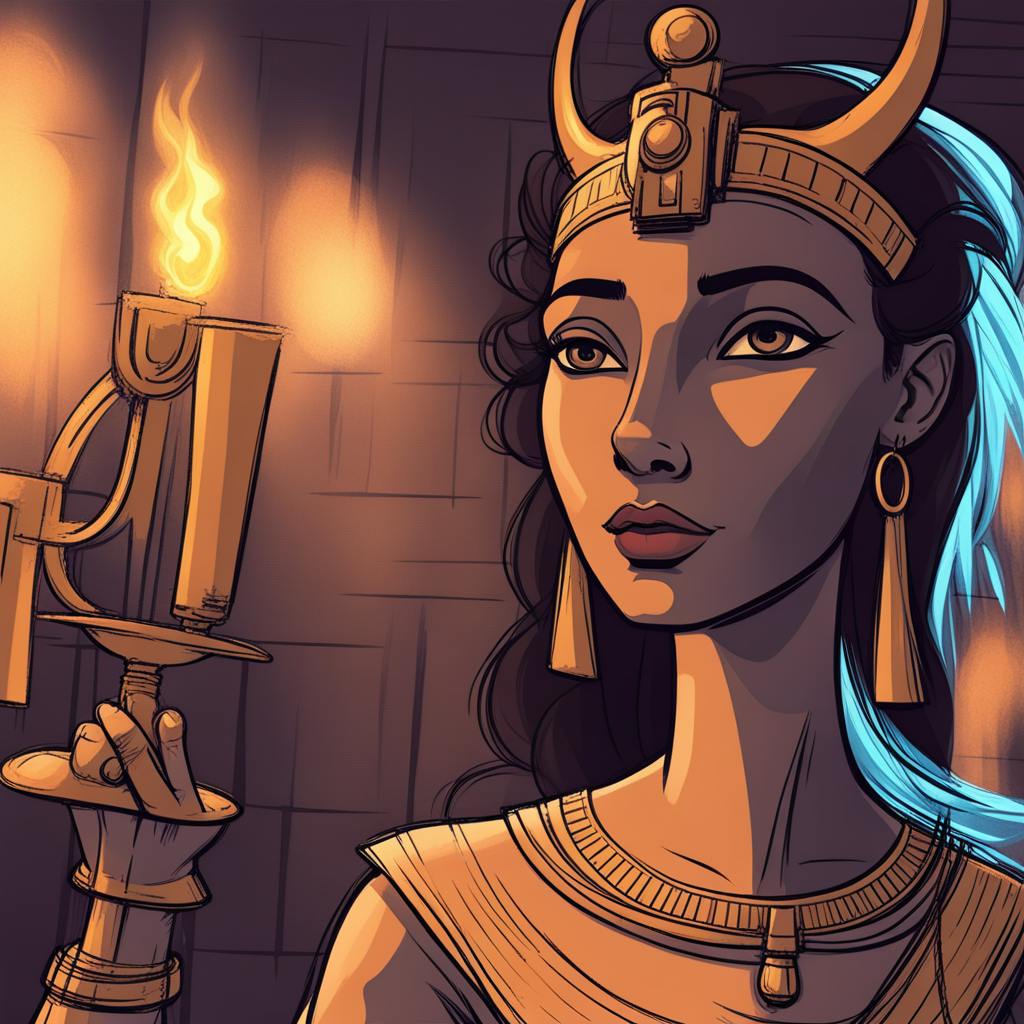Iconography, a critical component of art history and criticism, serves as a powerful tool for interpreting the complex points in artwork. By providing us with a visual vocabulary, iconography helps us decode the symbols and motifs that embellish paintings, sculptures, and other forms of artistic expression. In this article, we will explore various iconography examples that reveal how artists have conveyed ideas and messages through symbols across cultures and epochs.
Historical Perspectives on Iconography
Iconography has adorned artworks since antiquity, transforming over centuries. Ancient Egyptian art, for instance, offers striking iconography examples where deities are often illustrated with animal heads, symbolizing their divine attributes. The Ankh, a hieroglyph that resembles a cross with a loop at the top, is a quintessential representation of life and immortality, frequently appearing in numerous Egyptian artifacts.
Moving forward to the medieval era, Christian iconography becomes prominent, with enduring symbols such as the cross, lamb, and dove extensively used to convey religious themes. The lamb, in particular, represents Jesus Christ and sacrifice, often depicted in artworks from Byzantine mosaics to Gothic panel paintings.
Iconography Across Cultures
Culture plays a vital role in the development of iconography. Hindu art, rich with iconography examples, is adorned with deities like Ganesha, characterized by his elephant head, symbolizing wisdom and removal of obstacles. Each god and goddess is represented with various attributes that serve as iconographic tools, conveying spiritual narratives and philosophical teachings.
In East Asian art, the lotus flower stands out as a significant symbol. In both Buddhist and Hindu iconography, it represents purity and enlightenment, growing beautifully untainted from muddy waters. This imagery resonates across different mediums, from temple murals to intricate sculptures.

AI made with Mili Fay
Iconography in Modern and Contemporary Art
In the contemporary art scene, iconography is reinterpreted and often infused with new meaning. Artists like Andy Warhol utilized iconography in a futuristic context, through depictions of consumer goods and celebrities that comment on mass production and celebrity culture. His work provides modern iconography examples by transforming ordinary images into symbols of societal critique.
Similarly, Kehinde Wiley recontextualizes classical Western iconography by inserting African American subjects into traditional poses, thereby challenging historical narratives and prompting dialogues around identity and representation.
Frequently Asked Questions on Iconography
What is the purpose of iconography in art?
Iconography serves to convey deeper meanings and cultural narratives within artworks, allowing viewers to understand the political, philosophical, and religious contexts that shaped them.
How does iconography differ from symbolism?
While both iconography and symbolism involve the use of images to represent ideas, iconography refers specifically to the study and interpretation of these symbols within an artwork.
Can iconography change over time?
Indeed, as cultures evolve, so do their symbols. What once may have had a sacred or specific meaning can be transformed or repurposed to align with contemporary societal values.
FAQ: Iconography in Art History
What are some examples of iconography in different art periods?
Iconography is the visual symbols and imagery used to convey particular themes or messages in artwork. Throughout history, different periods have showcased distinct iconographies, often reflective of the cultural, religious, or social contexts of their times.
- Ancient Egypt: The ankh, scarab beetle, and eye of Horus are prominent symbols. The ankh represents life, while the scarab beetle is associated with rebirth. The eye of Horus symbolizes protection and royal power.
- Classical Antiquity (Greek and Roman): Greek art famously utilized iconography like the laurel wreath, representing victory and status, and the lyre, symbolizing music and culture. In Roman art, iconography included the eagle, a symbol of divine power and the emperor's authority.
- Medieval Period: Religious iconography thrived, with the cross symbolizing Christianity. In Gothic art, we see an extensive use of saints' symbols, such as St. Peter's keys or St. Catherine's wheel.
- Renaissance: The Renaissance saw a resurgence in mythological themes alongside religious ones, with symbols like the Venus representing beauty or apples alluding to temptation and sin.
- Baroque: Symbolism in Baroque art might include dramatic contrasts of light and dark to represent spiritual themes, or broken columns and hourglasses alluding to transience and mortality.
- Modern and Contemporary Periods: Modern art often includes more abstract symbols, like the soft watches in Salvador Dalí’s "The Persistence of Memory," which represent relativity and the fluidity of time.
How has iconography evolved across various geographical locations?
Iconography has developed distinctively across different regions due to the varied cultural beliefs, practices, and historical influences unique to each area.
- Asia: In regions influenced by Buddhism, such as India, China, and Japan, the lotus flower is a prevalent symbol of purity and enlightenment. Chinese art is rich with dragons symbolizing power and strength, while Japanese art frequently uses cherry blossoms to signify the transience of life.
- Africa: African iconography often revolves around ancestral reverence and the spiritual world. Masks and animal figures are common, often embodying spirits or deities in ritual contexts.
- Middle East: Islamic art is characterized by intricate geometric patterns and calligraphy, representing the infinite nature of Allah and avoiding figural representations due to religious beliefs.
- Western Europe: Christianity has been a significant influence, with the Virgin Mary and Christ being central figures in iconography. Symbols like the dove often signify peace or the Holy Spirit.
- Pre-Columbian Americas: In Mesoamerica, cultures like the Maya and Aztec used iconography such as serpents and jaguars to convey themes of power and divinity.
Can you provide numerous examples of iconography used in art to express ideas?
Certainly, art often employs iconography to elucidate complex ideas and narratives:
- Religious Iconography: The halo in Christian art represents divinity or sanctity, while the crescent moon in Islamic art is associated with the Islamic faith itself.
- Political Iconography: In Soviet art, imagery such as the hammer and sickle became symbols of the proletariat and communist ideology.
- Gender and Identity: In modern art, Andy Warhol's use of Marilyn Monroe's image critiques celebrity culture and identity construction.
- Environmental and Social Commentary: Banksy’s street art frequently uses rats as symbols of the marginalized in society, highlighting issues of power and rebellion.

AI made with Mili Fay
How does the use of iconography in art differ across time and cultures?
The use of iconography has evolved along with changes in societal values, technology, and intercultural exchanges:
- Temporal Evolution: In ancient times, iconography was often used in religious contexts to teach and reinforce beliefs, whereas modern and contemporary artists employ symbols to challenge or question societal norms.
- Cultural Variations: In Western cultures, iconography may focus more on individualism and secular themes, whereas Eastern traditions might emphasize more collective spiritual or philosophical ideas through their art.
- Hybridization and Globalization: Today, the globalization of cultures results in more intersectional iconography, where Eastern and Western symbols might merge to create new meanings in contemporary art.
As art continues to evolve, iconography remains a powerful tool for visual communication, offering insights into the cultural landscapes from which it emerges.
Conclusion
Examining numerous iconography examples illuminates the rich tapestry of human expression across time and geography. From ancient Egypt's sacred hieroglyphs to the dynamic reinterpretations in contemporary art, these symbols provide an invaluable window into the values, beliefs, and stories from diverse cultures. Iconography, through its versatility and profoundness, continues to invite us into deeper dialogues with the visual language of art.

